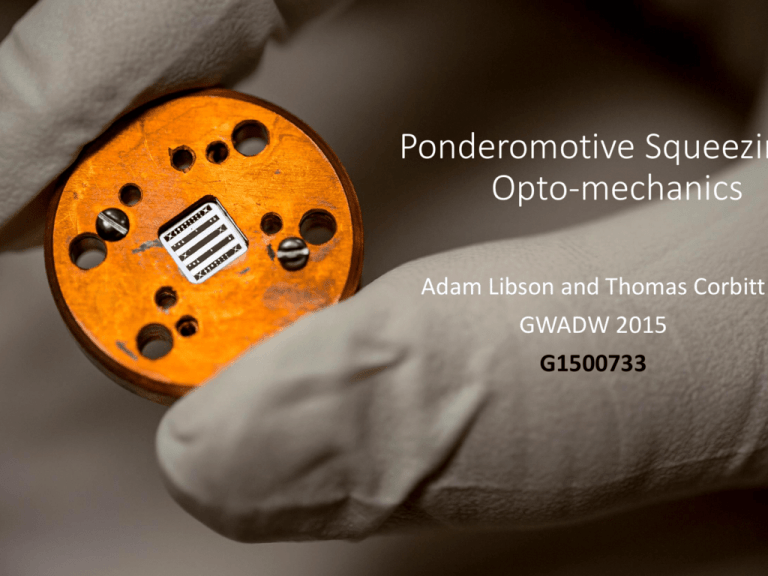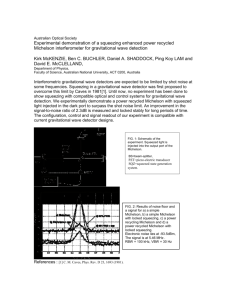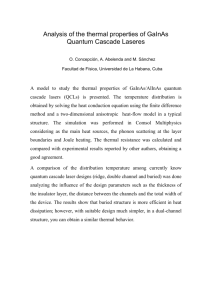G1500733-v1-opto - DCC
advertisement

Ponderomotive Squeezin Opto-mechanics Adam Libson and Thomas Corbitt GWADW 2015 G1500733 Outline • Intro to ponderomotive squeezing & optomechanics • State of the field • Our approach • Is any of this be useful for A+, Voyager, Lungo, etc? 2 Two pieces • Opto-mechanics • Essentially feedback between optical field and mechanical motion. • Optical spring, optical damping, parametric instability, angular instability. • Well understood and experimentally demonstrated. • Classical in nature, but changes behavior of quantum noise. • Quantum noise • Shot & radiation pressure noise, topologies, injection of squeezed light, production of squeezed light (ponderomotive). • Well understood (we think), but apart from injection of squeezed light, not experimentally demonstrated. 3 The forgotten resonance Optical noise correlations and beating the standard quantum limit in advanced gravitationalwave detectors Alessandra Buonanno and Yanbei Chen 2001 Class. Quantum Grav. 18 L95. (2001) Sensitivity improvement from optical spring more robust against optical loss because it amplifies signal. 4 Ponderomotive Squeezing • Amplitude fluctuations of incoming light cause fluctuations in position of cavity end mirror • Causes cavity length to change • Causes phase of reflected light to change • Amplitude fluctuations correlated to phase fluctuations • Generates squeezed state • If phase is rotated back to amplitude (detuned cavity, higher order optical modes), optical spring or parametric instability can form. 5 Squeezing with atoms Here we implement such a system, in which quantum photon-number fluctuations significantly drive the center of mass of an atomic ensemble inside a Fabry-Perot cavity. We observe sub-shot-noise ponderomotive squeezing of quantum fluctuations and also demonstrate that classical optical fluctuations can be attenuated by 26 dB or amplified by 20 dB with a weak input pump power of < 40 pW. Non-classical light generated by quantum-noise-driven cavity optomechanics, D. Brooks et al, Nature 488, 476-480 (2012). Stamper-Kurn group. 6 Squeezing with silicon microchip In spite of the mechanical resonator’s highly excited thermal state (10, 000 phonons), we observe squeezing at the level of 4.5 ± 0.5% below that of shot-noise over a few MHz bandwidth around the mechanical resonance frequency of 28 MHz. This squeezing is interpreted as an unambiguous quantum signature of radiation pressure shot-noise. Squeezed light from a silicon micromechanical resonator, A. Safavi-Naeini et al, Nature 500, 185-189 (2013). Painter group. 7 Squeezing with silicon nitride membrane We experimentally demonstrate strong and continuous optomechanical squeezing of 1.7 ± 0.2 dB below the shot noise level. Strong Optomechanical Squeezing of Light, T. Purdy et al, Phys. Rev. X 3 031012 (2013). Regal group. 8 Discussion of prior results • Impressive and important results (demonstrates that ponderomotive squeezing is real). Fundamental physics is identical to our interferometers. • …but: • Squeezing is small (<2 dB) in a narrow band around a mechanical resonance (150 kHz, 25 MHz, 1.5 MHz). • From either crystal or ponderomotive squeezing, we would like 5-10dB in wide bandwidth from 10 Hz to 10 kHz. • Not an ideal prototype for testing ideas, as advanced detectors will generate broadband ponderomotive squeezing. 9 Prototype experiment for QRPN, opto-mechanics • Many possible choices, but generally: • Small mass for large radiation pressure interaction • High mechanical Q and low frequency resonances for low thermal noise • High optical quality • Generally speaking: • Creating a large opto-mechanical interaction is not too difficult (see numerous experiments showing optical spring, PI), but: • Making the quantum noise larger from the thermal noise is usually the hard part. 10 Experimental Setup • Optomechanical cavity • Mass of cantilever: 250 ng • Length: 100 µm • Thickness: 325 nm • Natural Frequency: 100 Hz-1 kHz (presently using 273 Hz) Multilayer AlGaAs/GaAs (~40 layer pairs) processed into mirror padsand cantilevers 11 ≈ 𝟓 𝒎𝒎 ≈ 𝟏𝟎𝟎 µm Cryogenic Optomechnical Cavity Piezo mounted Input coupler • 1 cm long Cantilever Chip mount, 16 K • Cavity Finesse: ~60,000 Cold finger • Circulating Power: ~500 mW • High Optical Spring: (up to) 200 G10 Rods kHz Agilis Mount, 293 K 12 Cryogenic Operation • 273 Hz cantilever • Measured noise matches model at room temperature • Measured noise below modeled RPN from ~ 3 kHz-20 kHz 13 Ponderomotive Squeezing Detuning (linewidths) Readout Angle (rad) Squeezing (dB) 3 -0.51 1.70 2 -0.42 2.07 1.5 -0.34 2.29 1 -0.25 2.50 0.5 -0.13 2.67 14 Pondromotive Squeezing (Continued) Adam Libson Thermal Noise Modeling • COMSOL used for finite element analysis • Full anisotropic model of crystal mechanical properties • Used to calculate coupling to the cavity laser • Susceptibility and thermal noise calculated using SumOf-Modes Technique Thermo-Elastic Damping • Coefficient of thermal expansion leads to heat flow and losses when the cantilever flexes • Particularly important for drum head modes of the mirror pad • These modes are the dominant source of thermal noise above 30 kHz Damping Looks Structural What do you need for a useful Squeezer on a Chip • Small Oscillators • Small Mode Volume / Short Cavity • Room Temperature Operation (quantum effects dominate thermal noise even for a room temperature thermal bath) Fiber Coupled Cavity • Fiber mirror on one side of the cavity, flat mirror on the other • Allows a very short cavity with small mode volume • Simplified Coupling and Alignment • Uses standard single mode (or multimode) optical fiber Fiber Mirrors • Mirrors formed by ablating a fiber tip with a CO2 laser • Radius of curvature around 150-200 µm. • Resulting surface is effectively superpolished Towards Quantum Limited At Room Temperature Towards Quantum Limited At Room Temperature Towards Quantum Limited At Room Temperature Towards a Squeezer on a Chip Setup in vacuum Importance of Escape Efficiency Character of the Squeezing What’s needed for this to be used in advanced GW detectors • Problem: 4 dB of squeezing isn’t enough • Solution: Lower optical losses and even lower thermal noise. Gains needed are factors of 2, not orders of magnitude. These materials are an active area of research, and it is very reasonable to think these problems will be solved on a 10 year time scale. • Problem(?): System produces a squeezed field with non-zero amplitude instead of a squeezed vacuum state • Solution: Use filter cavites Beyond Squeezing What else can we do with these optomechanical systems? Quantum limited table-top system ideal for: • Studying the character of quantum noise • Testing different readout schemes • Tests of sensing beyond the SQL Optomechanically Induced Transparency • Drive laser couples optical mode with mechanical mode • Probe laser interrogates the resulting optomechanical system Cavity Transfer Function with OMIT • Bode Plot of the cavity transfer function for the probe laser • Red curve corresponds to the cavity response without the drive laser • Blue curve is with the drive laser coupling the optical and mechanical modes OMIT Dip LIGO is a giant optomechanics experiment Thank You MIT: Nergis Mavalvala Nancy Aggarwal Shannon Sankar Eric Oekler Tim Bodiya LSU: Thomas Corbitt Robi Singh Jon Cripe Andreas Muller’s Research Group at University of South Florida











